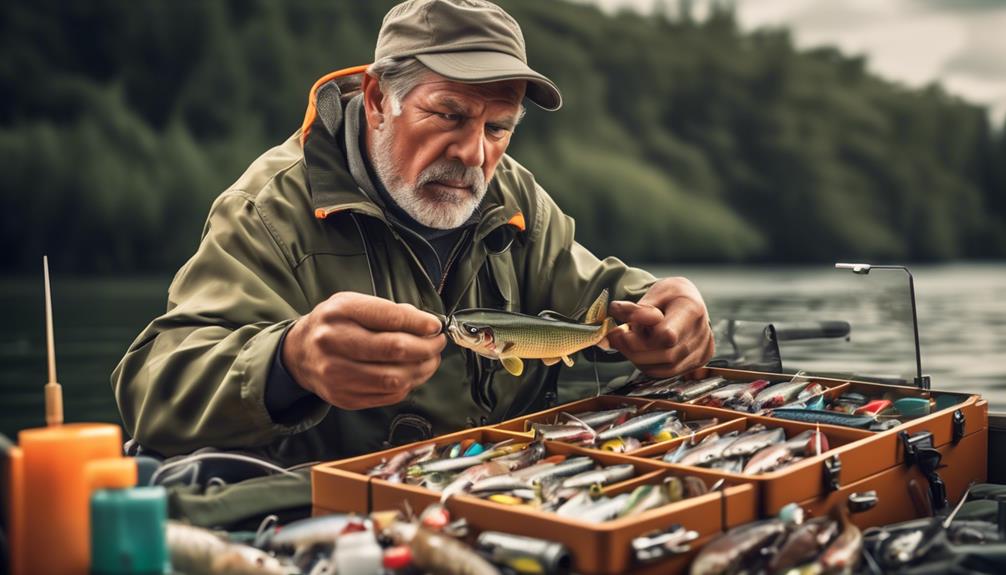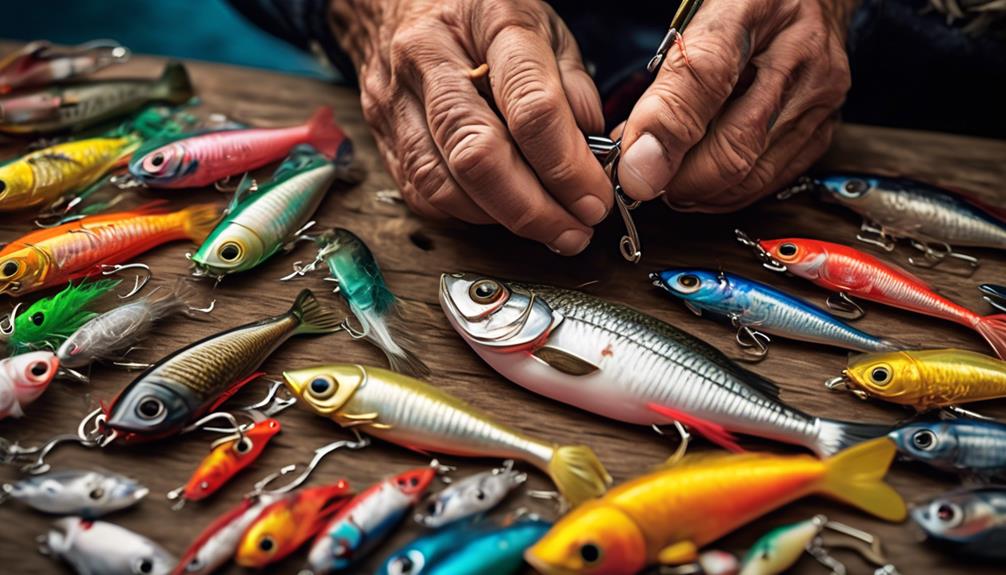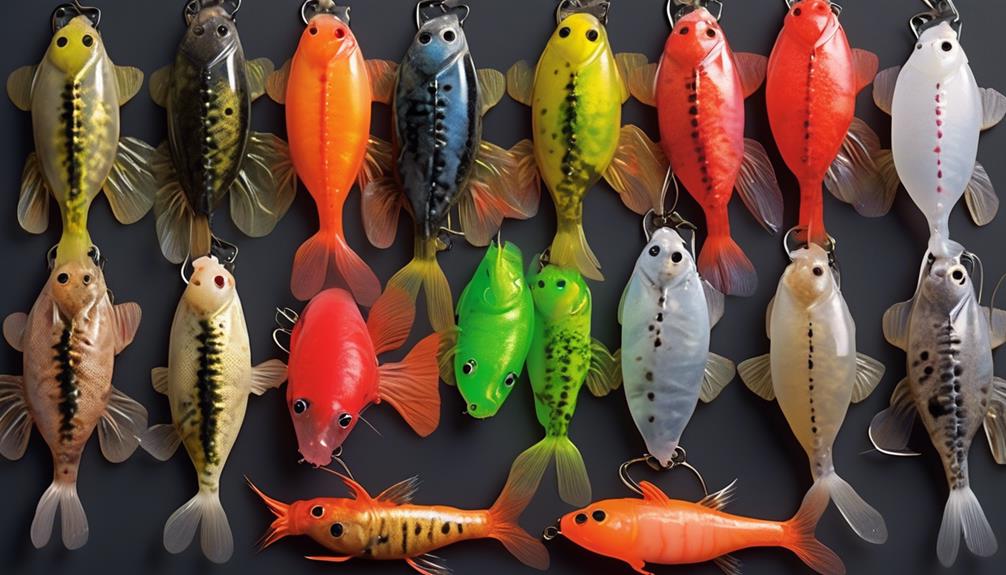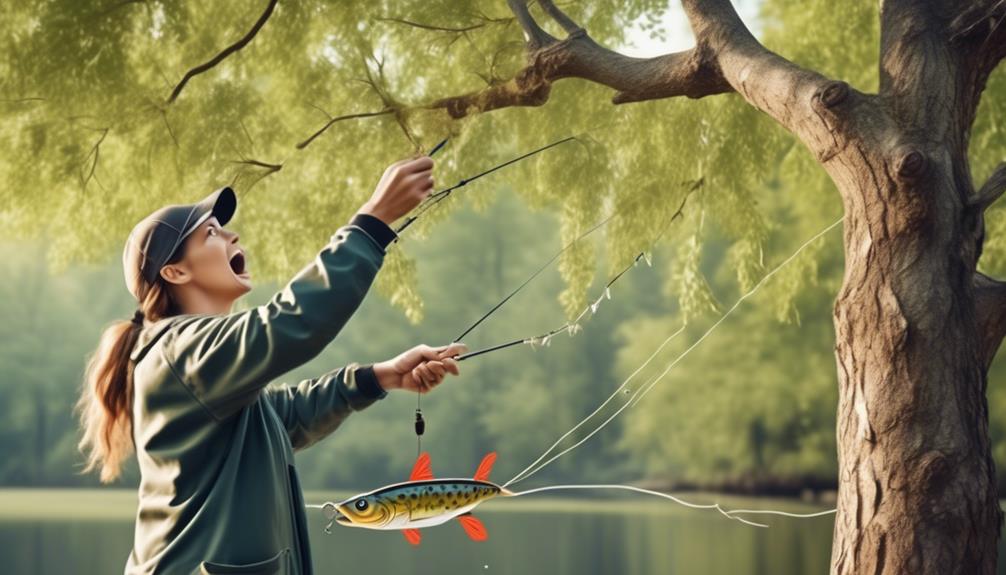When it comes to fishing, using bait and lures effectively is like casting a net in the vast ocean of possibilities. You want to be strategic and precise, ensuring that you entice the right catch. But how do you navigate the waters of bait and lure selection, presentation, and retrieval to maximize your success?
There are crucial tips and techniques that can elevate your game and lead you to reel in the big ones. So, let's dive into the world of bait and lure usage and uncover the essential strategies that will make you a more successful angler.
Understanding Bait and Lure Selection
Are you unsure about which bait and lure to choose for your next fishing trip? Selecting the right bait and lure can significantly impact your fishing success. Understanding the effectiveness of different baits and lures is crucial for a fruitful fishing experience.
When selecting bait, consider the type of fish you're targeting. Live bait, such as worms and minnows, is effective for many species, while artificial lures like spinners and crankbaits can also attract fish. Researching the feeding habits of the fish in your area can help you make an informed decision.
Understanding lure application is equally important. Different lures are designed to mimic specific types of prey, so knowing which lure to use in different conditions is key. For example, topwater lures are great for shallow areas with vegetation, while diving lures are better suited for deeper waters. Additionally, paying attention to the color and size of the lure can make a difference. In murky water, bright and noisy lures can attract fish, whereas in clear water, more natural-looking lures may be more effective.
Experimenting with different baits and lures is also essential. Fish behavior can change based on weather, time of day, and water conditions. Don't be afraid to try new techniques and switch up your bait and lure choices if you're not getting bites.
Identifying Target Species and Conditions
When targeting specific species and considering environmental conditions, it's crucial to align your bait and lure selection with the feeding habits and habitats of your intended catch. Identifying the target location is essential to determine the species you'll be targeting. Different fish species inhabit various environments, such as lakes, rivers, or deep sea, and understanding the specific location will help you select the appropriate bait and lures.
Moreover, weather conditions play a significant role in the behavior of fish. For instance, during overcast days, fish tend to move closer to the surface to feed, making topwater lures and baits more effective. On the other hand, in bright sunlight, fish may seek shelter in deeper waters or under vegetation, requiring different types of lures and baits to reach them effectively.
When identifying the target species, consider the feeding habits of the fish. Some species are bottom feeders, while others primarily feed on insects at the water's surface. Knowing the feeding habits of your target species will help you select the right type of bait or lure to attract them.
Proper Presentation Techniques
To effectively present your bait or lure, consider the speed and depth at which you retrieve it, as these factors can greatly influence your success in attracting and enticing the targeted fish. Proper presentation techniques play a crucial role in maximizing your chances of a successful catch. Here are some essential tips to enhance your bait and lure presentation:
- Bait Placement: The correct placement of your bait is essential for attracting the fish. Ensure that your bait is positioned where the target species are most likely to be found. Research the behavior and habitat of the fish you're targeting to determine the ideal placement for your bait.
- Lure Movement: When using lures, the movement is key to attracting fish. Vary the speed and rhythm of your retrieve to mimic the behavior of natural prey. Experiment with different movements such as jerking, twitching, or steady reeling to determine what entices the fish to strike.
- Depth Control: Adjusting the depth at which your bait or lure operates can significantly impact your success. Some fish species prefer feeding at specific depths, so understanding their behavior is crucial. Use tools such as depth finders or fish finders to identify the ideal depth for your presentation.
Utilizing Natural and Artificial Baits
Considering the importance of bait and lure presentation for maximizing your chances of a successful catch, let's now focus on the effective utilization of natural and artificial baits to enhance your fishing experience.
When it comes to choosing between live bait and artificial lures, each has its advantages. Live bait, such as worms, minnows, or leeches, can be highly effective as it presents a natural and enticing meal for fish. On the other hand, artificial baits like plastic worms, crankbaits, and spinners offer the advantage of durability and reusability, making them cost-effective and convenient.
In deciding between live bait and artificial lures, consider the fishing conditions and the behavior of the target species. For instance, if you're targeting a species known for being more attracted to live prey, then using live bait might be the better option. On the other hand, if you're fishing in an area with heavy vegetation or obstacles where live bait might easily get snagged, artificial lures would be the more practical choice.
Furthermore, regardless of whether you use live bait or artificial lures, it's important to preserve the quality of your bait. Bait preservation techniques such as keeping live bait in a cool and aerated container, using bait coolers, and properly storing artificial lures to prevent damage and deterioration can significantly impact your fishing success.
Mastering Lure Retrieval Methods
Mastering lure retrieval methods requires understanding the behavior of the target species and adjusting your technique accordingly. Different fish species respond to various retrieval methods, so it's crucial to adapt your approach for a successful catch.
When it comes to lure casting, it's essential to consider the direction and distance. Always aim for accuracy when casting your lure. Ensure that you cast near structures where fish are likely to hide, such as rocks, logs, or vegetation. Additionally, be mindful of the wind direction to maximize your casting distance and accuracy.
Retrieval speed plays a vital role in attracting the attention of the fish. Experiment with various speeds to find the optimal one for the specific lure and fish species you're targeting. Some fish may be enticed by a fast and erratic retrieve, while others prefer a slower, more steady approach. Pay attention to any signs of fish following the lure and adjust your retrieval speed accordingly.
Varying your retrieval technique can also make your lure more appealing to the fish. Incorporate pauses, jerks, or sudden changes in direction to mimic the movement of natural prey. This can trigger a predatory response from the fish, increasing the likelihood of a strike.
Adjusting Bait and Lure Depth
When adjusting bait and lure depth, remember to factor in the behavior of the target species and make the necessary adaptations to improve your chances of a successful catch. Depth adjustment is a critical element of fishing strategies, as it directly impacts the visibility and accessibility of your bait or lure to the fish. Different species of fish have varying preferences when it comes to the depth at which they feed, and understanding these preferences is key to optimizing your fishing success.
To effectively adjust the depth of your bait or lure, begin by researching the typical behavior of the fish you're targeting. Some species are known to be bottom feeders, while others prefer to stay closer to the surface. Once you have a good understanding of the fish's behavior, you can select the appropriate fishing technique and adjust the depth accordingly. For example, if you're targeting bottom-feeding fish, using a weighted rig or sinker can help ensure that your bait reaches the desired depth.
Another important consideration when adjusting bait and lure depth is the water temperature. In colder conditions, fish may be more sluggish and less likely to move to higher levels in the water, so adjusting the depth to reach them at their preferred level becomes crucial.
Remember that experimenting with different depths is often necessary to find the most effective approach. By being attentive to the behavior of the target species and making thoughtful depth adjustments, you can significantly improve your chances of a successful catch.
Enhancing Bait and Lure Attractiveness

Looking to increase your chances of a successful catch? Enhancing the attractiveness of your bait and lure is crucial for drawing in fish. Here are some tips to help you make your bait and lure more appealing:
- Bait Placement: The placement of your bait is essential for attracting fish. Make sure to consider the specific species you're targeting and adjust the placement of your bait accordingly. Some fish may prefer bait placed near the surface, while others may be found closer to the bottom. Understanding the behavior of the fish you're trying to catch will help you determine the best placement for your bait.
- Environmental Factors: Consider environmental factors such as water temperature, clarity, and current when enhancing bait and lure attractiveness. Different environmental conditions can impact the effectiveness of your bait and lure. For example, in murky water, using brightly colored or scented bait can help attract fish. Similarly, adjusting your lure's movement to mimic the natural behavior of prey in the specific environment can make it more enticing to fish.
- Experiment with Different Baits and Lures: Don't be afraid to try out a variety of baits and lures to see what works best in different conditions. Some fish may be more attracted to live bait, while others may respond better to artificial lures. By experimenting with different options, you can find the most effective bait and lure for your target fish in various environments.
Maintenance and Storage Tips
To ensure the effectiveness of your bait and lures, it's essential to properly maintain and store them between fishing trips. Proper storage is crucial for preserving the quality and effectiveness of your bait and lures. When not in use, make sure to store them in a cool, dry place to prevent damage from humidity or extreme temperatures. Consider investing in tackle boxes or containers specifically designed for bait and lures to keep them organized and protected.
Long-term maintenance is also important to ensure that your bait and lures remain in good condition. After each fishing trip, thoroughly clean and dry your bait and lures to remove any residue or debris. This not only helps maintain their appearance but also prevents any potential damage caused by salt, dirt, or other contaminants. Additionally, regularly inspect your bait and lures for signs of wear and tear, such as rusting hooks or fraying skirts, and replace any damaged components as needed.
Furthermore, consider applying a protective coating or lubricant to metal components to prevent corrosion and maintain their functionality over time. This simple step can significantly extend the lifespan of your bait and lures.
Frequently Asked Questions
Can Bait and Lure Effectiveness Be Impacted by the Time of Day and Weather Conditions?
Bait and lure effectiveness can definitely be influenced by the time of day and weather conditions.
The impact of moon phases on bait and lure effectiveness is significant, as different phases can affect fish feeding patterns.
Furthermore, the effect of wind speed on bait and lure success shouldn't be underestimated.
It's important to consider these factors when planning your fishing trip to maximize your chances of success.
How Can I Determine the Best Color and Size of Bait or Lure to Use in Different Fishing Situations?
When choosing bait or lures for fishing, there are several factors to consider for their effectiveness.
Firstly, consider the water clarity and the type of fish you're targeting. Different fish are attracted to different types of bait, so it's important to choose the right one based on the fish species you want to catch.
Secondly, take into account the behavior of the fish in that particular area. Some fish are more aggressive and respond well to fast-moving lures, while others may be more cautious and prefer slower-moving bait.
Size and color selection also play a crucial role in attracting fish. Larger lures can attract bigger fish, while smaller ones may work better for smaller species. Additionally, the color of the bait should match the local baitfish or the water's natural hues for the best results.
Are There Any Specific Techniques for Using Bait and Lures in Heavily Vegetated or Rocky Areas?
In heavily vegetated or rocky areas, bait presentation and casting techniques are crucial. You should aim to cast near the edges of the vegetation or rocks, allowing your bait or lure to fall naturally into the clear areas.
When retrieving your bait or lure, use a slow and steady motion to avoid getting caught in the vegetation. Additionally, be prepared to set the hook quickly and firmly to avoid snagging.
What Are Some Ways to Prevent Bait and Lures From Getting Tangled or Caught on Underwater Obstacles?
To prevent snags and tangles with underwater obstacles, consider the fish behavior and adjust your angling techniques.
Try casting parallel to the shoreline to avoid rocks and vegetation.
Use weedless lures and hooks to minimize snags.
Opt for stronger and thicker fishing lines to withstand potential tangles.
Master knot tying to secure your bait and lures effectively.
Stay alert and adjust your technique if you feel resistance, preventing snags before they happen.
Are There Any Special Considerations for Using Bait and Lures in Different Bodies of Water, Such as Rivers, Lakes, or Saltwater Environments?
When using bait and lures in different bodies of water, like rivers, lakes, or saltwater, there are special considerations to keep in mind.
Tidal influences play a role in saltwater environments, affecting bait presentation and lure retrieval techniques.
Freshwater considerations include understanding the behavior of the fish and adjusting your approach accordingly.
It's important to adapt your tactics to the specific conditions of each body of water for successful fishing.
Conclusion
Now that you've learned the essential tips for effective bait and lure usage, it's time to put them into practice.
Remember to carefully select your bait and lure, consider the conditions and target species, and master proper presentation and retrieval techniques.
Whether you're using natural or artificial baits, adjusting depth, or enhancing attractiveness, these tips will surely improve your fishing success.
Don't forget to properly maintain and store your bait and lures for future use.
Happy fishing!



